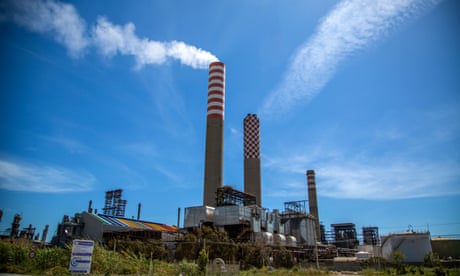
Barclays is being accused by environmental groups of greenwashing after helping to arrange €4bn (£3.4bn) in financing for the Italian oil company Eni in a way that allows them to qualify towards its $1tn sustainable financing goal.
Environmental groups have said the London-based bank is deliberately misleading the public by labelling the financial instruments as “sustainable” at the same time that Eni is in the midst of a multibillion-pound fossil fuel expansion drive designed to increase production.
An investigation by the journalism organisation Point Source has revealed that the deals for a revolving credit line were completed last year, months after the Milan-based company announced it intended to increase its spending on the production of oil and gas by at least a third over four years, investing between €24bn and €26bn.
In February 2023, Eni said it was aiming to increase its production of oil and gas by between 12.6% and 17% over the four-year period to the end of 2026.
Eni’s oil and gas expansion plans include a project to develop the Verus gas field, which could emit 7.5m tonnes of carbon dioxide a year and has been described as a “carbon bomb” by the Institute for Energy Economics and Financial Analysis.
Owing to its expansion plans, Eni’s production in 2030 is projected to be 35% higher than that required to align with the International Energy Agency’s net zero emissions by 2050 scenario, according to the campaign group Reclaim Finance. Eni says it still aims to achieve net zero by 2050.
The financing Barclays helped Eni raise includes a sustainability-linked bond (SLB) worth €1bn and a revolving sustainability-linked loan (SLL) worth €3bn.
While there is nothing in the terms of these financial instruments to prevent Eni from using the funds raised to develop oil and gas projects, including the Verus gas field, Barclays says the financing qualifies to be counted towards its 2030 sustainability target because the interest rates have been linked to emissions goals.
However, environmental groups and financial experts say the goals in the contracts, which exclude scope 3 emissions, are unambitious and incompatible with the internationally agreed target to limit any rise in global temperature to 1.5C above preindustrial levels.
Scope 1 emissions come from sources that an organisation owns or controls directly, while scope 2 emissions are caused indirectly and come from where the energy it uses is produced. Scope 3 emissions include all other indirect sources in the value chain of an organisation that are not within scope 1 and 2.
The exclusion of scope 3 emissions in the targets has been criticised because the majority of Eni’s emissions, such as those from burning the oil and gas it produces, are considered scope 3.
Jo Richardson, the head of research at the non-profit research organisation Anthropocene Fixed Income Institute, said: “There are a lot of sustainability-linked financial products that are not effective – and these are two classic examples.
“To see a really effective sustainability structure in the oil and gas sector you would need to see a company with a clear and committed plan to reducing scope 3 emissions.”
Lucie Pinson, the founder and director of Reclaim Finance, said: “Issuing an SLL like this is an easy way for Eni to raise money without having to make a significant climate effort or change anything about its business. It also allows banks who have pledged net zero to keep financing the worst climate offenders while pretending to support their transition.”
In June last year, the Financial Conduct Authority sent a letter to financial institutions warning of “the possibility of potential risks to market integrity and suspicion of greenwashing in the context of SLLs”.
It said it was concerned about “weak incentives, potential conflicts of interest, and suggestions of low ambition and poor design”.
In February this year, Barclays announced that it would no longer provide direct funding for new oil and gas projects. However, financing in the form of SLBs and SLLs could continue for companies that are developing new oil and gas fields because the bank does not consider this to be “direct” project financing.
Huw Davies, senior finance adviser at the campaign group Make My Money Matter, said: “Not only are the UK’s largest banks [continuing to help] finance companies that are expanding oil and gas production, but this shows they’re doing so under the pretence of so-called ‘sustainable’ finance.
“Barclays’ decision to provide billions in corporate finance to Eni – a company which continues to develop new oil and gas – is enabling fossil fuel expansion, and contradicting their claims to be serious about sustainability.”
When contacted by the Guardian, Barclays declined to comment.
In a statement, Eni said it chose the targets in its sustainability-linked financial instruments “tailored to their maturity range” and because of this “it was not possible to use a scope 3 target”.
It added: “Eni has built a business model that puts sustainability at the centre of every business activity, including financial strategy.
“The development of the Verus project is consistent with Eni’s objective of achieving scope 1 and 2 carbon neutrality in all its businesses by 2035 … In particular, the development of Verus would include the use of capture and storage of CO2 to supply decarbonised energy in line with Eni’s objectives.”
Barclays was a lead arranger in the $3bn sustainability-linked revolving credit facility that was provided to Eni by 26 global financial institutions including Italy-based Mediobanca Group, New York-based Citi, and France’s Natixis.
The SLL has a time period of five years and its sustainability targets relate to the installed capacity for the production of electricity from renewable sources as well as emissions goals.
Barclays was one of three banks that structured the $1bn SLB for Eni. The other banks involved were Goldman Sachs and JP Morgan Chase. All banks declined to comment.